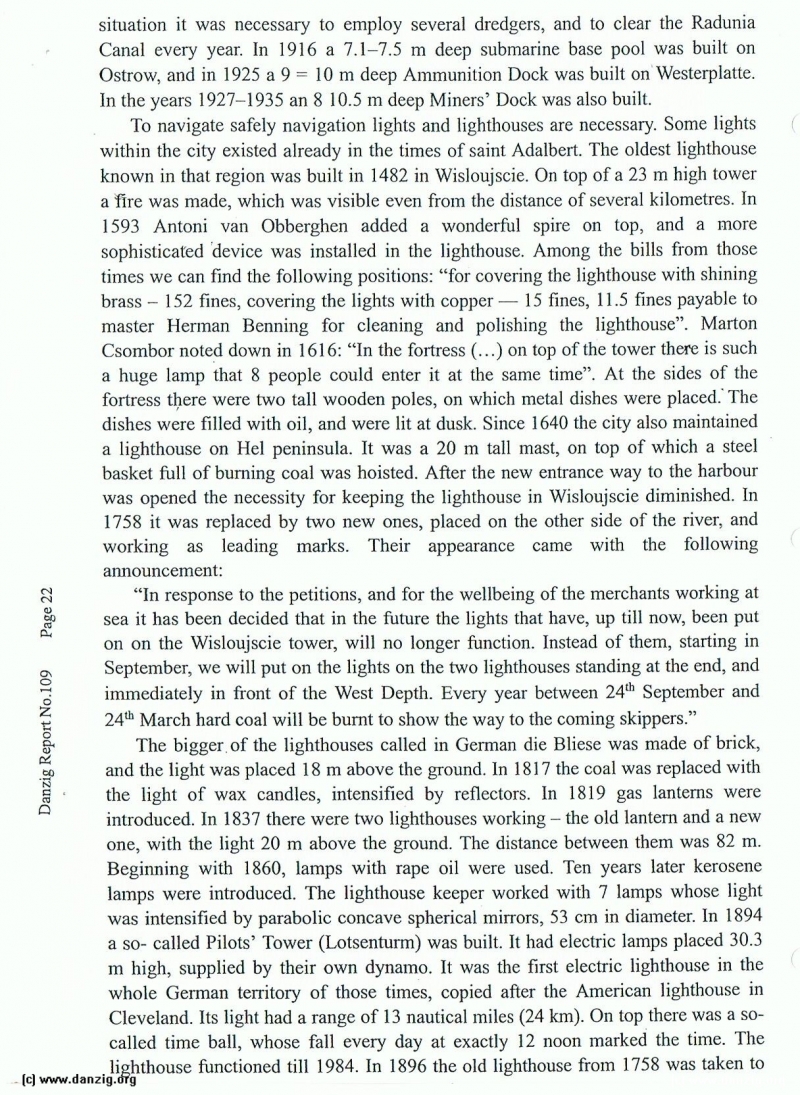
situation it was necessary to employ several dredgers, and to clear the Radunia Canal every year. In 1916 a 7.1—7.5 m deep submarine base pooi was built on Ostrow, and in 1925 a 9 = 10 rn deep Ammunition Dock was built on Westerplatte. in the years 1927—1935 an 8 10.5 m deep Miners’ Dock was also built.
To navigate safely navigation lights and lighthouses are necessary. Some lights within the city existed already in the times of saint Adalbert. The oldest lighthouse known in that region was built in 1482 in Wisloujscie. On top of a 23 m high tower a fire was made, which was visible even from the distance of several kilometres. In 1593 Antoni van Obberghen added a wonderful spire on top, and a more sophisticated device was installed in the lighthouse. Among the bills from those times we can find the following positions: “for covering the lighthouse with shining brass — 152 fines, covering the lights with copper — 15 fines, 11.5 fines payable to master Herman Benning for cleaning and polishing the lighthouse”. Marton Csombor noted down in 1616: “In the fortress (...) on top of the tower there is such a huge lamp that 8 people could enter it at the same time”. At the sides of the fortress tlere were two tall wooden poles, on which metal dishes were placed.’ The dishes were filled with oil, and were lit at dusk. Since 1640 the city also maintained a lighthouse on Hel peninsula. It was a 20 m tall mast, on top of which a steel basket full of burning coal was hoisted. After the new entrance way to the harbour was opened the necessity for keeping the lighthouse in Wisloujscie diminished. In 1758 it was replaced by two new ones, placed on the other side of the river, and working as leading marks. Their appearance came with the following announcement:
“In response to the petitions, and for the wellbeing of the merchants working at sea it has been decided that in the future the lights that have, up till now, been put on on the Wisloujscie tower, will no longer function. Instead of them, starting in September, we will put on the lights on the two lighthouses standing at the end, and immediately in front of the West Depth. Every year between 24th September and 24 March hard coal will be burnt to show the way to the coming skippers.”
The bigger of the lighthouses called in German die Bliese was made of brick, and the light was placed 18 m above the ground. in 1817 the coal was replaced with the light of wax candles, intensified by reflectors. in 1819 gas lanterns were introduced. In 1837 there were two lighthouses working — the old lantern and a new one, with the light 20 m above the ground. The distance between them was 82 m. Beginning with 1860, lamps with rape oil were used. Ten years later kerosene lamps were introduced. The lighthouse keeper worked with 7 lamps whose light was intensified by parabolic concave spherical mirrors, 53 cm in diameter. In 1894 a so- called Pilots’ Tower (Lotsenturm) was built. It had electric lamps placed 30.3 rn high, supplied by their own dynamo. It was the first electric lighthouse in the whole German territory of those times, copied after the American lighthouse in Cleveland. Its light had a range of 13 nautical miles (24 km). On top there was a soc alled time ball, whose fall every day at exactly 12 noon marked the time. The lighthouse functioned till 1984. In 1896 the old lighthouse from 1758 was taken to
Danzig Report Vol. 1 - Nr. 109 - October - November - December - 2000, Page 28.
Hits: 3718
Added: 29/07/2015
Copyright: 2025 Danzig.org

